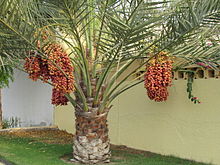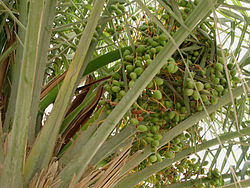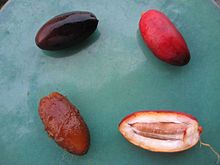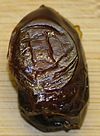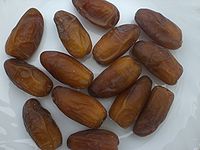- Phoenix dactylifera
-
Phoenix dactylifera Date palms, Rashidiya, Dubai Scientific classification Kingdom: Plantae (unranked): Angiosperms (unranked): Monocots (unranked): Commelinids Order: Arecales Family: Arecaceae Genus: Phoenix Species: P. dactylifera Binomial name Phoenix dactylifera
L.The date palm (Phoenix dactylifera) is a palm in the genus Phoenix, cultivated for its edible sweet fruit. Although its place of origin is unknown because of long cultivation, it probably originated from lands around the Persian Gulf.[1] It is a medium-sized plant, 15–25 m tall, growing singly or forming a clump with several stems from a single root system. The leaves are 3–5 m long, with spines on the petiole, and pinnate, with about 150 leaflets; the leaflets are 30 cm long and 2 cm wide. The full span of the crown ranges from 6 to 10 m.
Contents
Etymology
The species name dactylifera "date-bearing" comes from Ancient Greek dáktulos "date" (also "finger")[2] and the stem of the Latin verb ferō "I bear".[3]
History of dates
Dates have been a staple food of the Middle East for thousands of years. They are believed to have originated around the Persian Gulf, and have been cultivated since ancient times from Mesopotamia to prehistoric Egypt, possibly as early as 4000 BCE. The Ancient Egyptians used the fruits to be made into date wine, and ate them at harvest. There is archaeological evidence of date cultivation in eastern Arabia in 6000 BCE. (Alvarez-Mon 2006).
In later times, traders spread dates around South and South West Asia, northern Africa, and Spain and Italy. Dates were introduced into Mexico and California by the Spaniards by 1765, around Mission San Ignacio.
A date palm cultivar, known as Judean date palm is renowned for its long-lived orthodox seed, which successfully sprouted after accidental storage for 2000 years.[4] This particular seed is presently reputed to be the oldest viable seed but the upper survival time limit of properly stored seeds remains unknown.[5]
Dates
The fruit is known as a date.[6] The fruit's English name, as well as the Latin species name dactylifera, both come from the Greek word for "finger," dáktulos, because of the fruit's elongated shape. Dates are oval-cylindrical, 3–7 cm long, and 2–3 cm diameter, and when unripe, range from bright red to bright yellow in colour, depending on variety. Dates contain a single seed about 2–2.5 cm long and 6–8 mm thick. Three main cultivar groups of date exist: soft (e.g. 'Barhee', 'Halawy', 'Khadrawy', 'Medjool'), semi-dry (e.g. 'Dayri', 'Deglet Noor', 'Zahdi'), and dry (e.g. 'Thoory'). The type of fruit depends on the glucose, fructose and sucrose content.
The date palm is dioecious, having separate male and female plants. They can be easily grown from seed, but only 50% of seedlings will be female and hence fruit bearing, and dates from seedling plants are often smaller and of poorer quality. Most commercial plantations thus use cuttings of heavily cropping cultivars. Plants grown from cuttings will fruit 2–3 years earlier than seedling plants.
Dates are naturally wind pollinated but in both traditional oasis horticulture and in the modern commercial orchards they are entirely pollinated manually. Natural pollination occurs with about an equal number of male and female plants. However, with assistance, one male can pollinate up to 100 females. Since the males are of value only as pollinators, this allows the growers to use their resources for many more fruit producing female plants. Some growers do not even maintain any male plants as male flowers become available at local markets at pollination time. Manual pollination is done by skilled labourers on ladders. In some areas such as Iraq the pollinator climbs the tree using a special climbing tool that wraps around the tree trunk and the climber's back to keep him attached to the trunk while climbing. Less often the pollen may be blown onto the female flowers by a wind machine.
Parthenocarpic cultivars are available but the seedless fruit is smaller and of lower quality.[citation needed]
Dates ripen in four stages, which are known throughout the world by their Arabic names kimri (unripe), khlal (full-size, crunchy), rutab (ripe, soft), tamr (ripe, sun-dried). A 100 gram portion of fresh dates is a source of vitamin C[citation needed] and supplies 230 kcal (960 kJ) of energy. Since dates contain relatively little water, they do not become much more concentrated upon drying, although the vitamin C is lost in the process.
Dates are an important traditional crop in Turkey, Iraq, Arabia, and north Africa west to Morocco and are mentioned more than 50 times in the Bible. In Islamic countries, dates and yogurt or milk are a traditional first meal when the sun sets during Ramadan. Dates (especially Medjool and Deglet Noor) are also cultivated in southern California, Arizona and southern Florida in the United States.
Date palms can take 4 to 8 years after planting before they will bear fruit, and produce viable yields for commercial harvest between 7 to 10 years. Mature date palms can produce 80–120 kilograms (176–264 lb) of dates per harvest season, although they do not all ripen at the same time so several harvests are required. In order to get fruit of marketable quality, the bunches of dates must be thinned and bagged or covered before ripening so that the remaining fruits grow larger and are protected from weather and pests such as birds.
Cultivars of dates
A large number of date cultivars are grown. The most important are:
- Aabel — common in Libya.
- Ajwah — from the town of Medina in Saudi Arabia, it is the subject of a famous Hadith of the Prophet Muhammad.
- Al-Barakah — from Saudi Arabia.
- Amir Hajj or 'Amer Hajj' — from Iraq, these are soft with a thin skin and thick flesh, sometimes called "the visitor's date" because it is a delicacy served to guests.
- 'Abid Rahim (Arabic: عبد رحيم), from Sudan. In Nigeria it is called Dabino and used by Muslims to break their fast.
- Barakawi (Arabic: بركاوي), from Sudan.
- Barhee or (barhi) (from Arabic barh, a hot wind) — these are nearly cylindrical, light amber to dark brown when ripe; soft, with thick flesh and rich flavour. One of the few varieties that are good in the khalal stage when they are yellow (like a fresh grape as opposed to dry, like a raisin).
- Bireir (Arabic: برير) — from Sudan.
- Datça Date - Turkey
- Deglet Noor (Arabic: دڤلة النور 'date of light') — so named because the centre appears light or golden when held up to the sun. This is a leading date in Libya, Algeria, the USA, and Tunisia, and in the latter country it is grown in inland oases and is the chief export cultivar. It is semi-dry and not very sweet.
- Derrie or 'Dayri' (the 'Monastery' date) — from southern Iraq — these are long, slender, nearly black, and soft.
- Empress — developed by the DaVall Family in Indio California USA from a seedling of 'Thoory'. It is large, and is softer and sweeter than 'Thoory'. It generally has a light tan top half and brown bottom half.
- Fardh or Fard - common in Oman, deep dark brown, tender skin, sweet flavor, small seed. Keeps well when well packed.
- Ftimi or 'Alligue' — these are grown in inland oases of Tunisia.
- Holwah (Halawi) (Arabic: 'sweet') — these are soft, and extremely sweet, small to medium in size.
- Haleema — in Hoon, Libya (Haleema is a woman's name).
- Hayany — from Egypt (Hayani) (Hayany is a man's name) — these dates are dark-red to nearly black and soft.
- Iteema — common in Algeria.
- Khajur — common in India / Pakistan.
- Kenta — common in Tunisia.
- Khadrawy (Arabic: 'green') — a cultivar favoured by many Arabs, it is a soft, very dark date.
- Khalasah (Arabic: 'quintessence') — one of the most famous palm cultivars in Saudi Arabia, famous for its sweetness level that is not high nor low, thus, suits most people. Its fruit is called 'Khlas'. Its famous place is 'Huffuf' (Al-Ahsa) and 'Qatif' in the Eastern Province of Saudi Arabia (Al-Sharqheyah).
- Khastawi (Khusatawi, Kustawy) — this is the leading soft date in Iraq; it is syrupy and small in size, prized for dessert.
- Maktoom (Arabic: 'hidden') — this is a large, red-brown, thick-skinned, soft, medium-sweet date.
- Manakbir — a large fruit that ripens early.
- Medjool or (Mejhool) (Arabic: 'unknown') — from Morocco, also grown in the USA, Saudi Arabia, Jordan, the Palestinian territories and Israel; a large, sweet and succulent date.
- Migraf (Mejraf) — very popular in Southern Yemen, these are large, golden-amber dates.
- Mgmaget Ayuob — from Hoon, Libya.
- Mishriq (Arabic: 'East' — مشرق) — from Sudan and Saudi Arabia.
- Mozafati — from Iran, where it is mainly grown in Kerman province, and often named "Bam (Mozafati) dates", after a city in that province. It is a dark, soft and sweet date of medium size. It is exceptionally well-suited for fresh consumption, because of its long shelf life. At a temperature of −5 degrees Celsius (23 °F) it can be kept for up to 2 years. It accounts for 10% of total Iranian date crop. (100,000 tons[vague], of which 30% is exported).
- Nabtat-seyf — in Saudi Arabia.
- Rotab — from Iran, they are dark and soft.
- Sag‘ai — from Saudi Arabia.
- Saidy (Saidi) — soft, very sweet, these are popular in Libya.
- Sayer (Sayir) (Arabic: 'common') — these dates are dark orange-brown, of medium size, soft and syrupy.
- Sekkeri — (lit. sugary) (Arabic: سكري) Dark brown skin; distinctly sweet and soft flesh, from Saudi Arabia, it is the most expensive kind.
- Sellaj — (Arabic: سلّج)in Saudi Arabia.
- Tagyat — common in Libya.
- Tamej — in Libya.
- Thoory (Thuri) — popular in Algeria, this dry date is brown-red when cured with a bluish bloom and very wrinkled skin. Its flesh is sometimes hard and brittle but the flavour described as sweet and nutty.
- Umeljwary — in Libya.
- Umelkhashab — Brilliant red skin; bittersweet, hard white flesh (Saudi Arabia).
- Zahidi (Arabic: '[Of the] ascetic') — these medium size, cylindrical, light golden-brown semi-dry dates are very sugary, and sold as soft, medium-hard and hard.
- Zaghloul (Arabic: زغلول) -Dark red skin, long, and very crunchy when served fresh (as they invariably are), their sugar content is so high that it desiccates the mouth. The variety is essentially exclusive to Egypt, where it is subject to an element of nationalist sentiment (Saad Zaghloul being a major Egyptian national hero).
The Gaza Strip, especially Dier al Balah, "Village of Dates", is known for its exceptionally sweet red dates. There are more than 100 known cultivars in Iraq.[clarification needed] It should be noted, however, that a cultivar can have several names depending on the locality.
Production
Top Twenty Dates Producers — 2009
(1000 metric tonnes) Egypt
Egypt1,350.00  Iran
Iran1,088.04  Saudi Arabia
Saudi Arabia1,052.40  Pakistan
Pakistan735.28  United Arab Emirates
United Arab Emirates759.00  Algeria
Algeria600.70  Iraq
Iraq507.00  Sudan
Sudan339.30  Oman
Oman278.59  Libya
Libya160.10  Tunisia
Tunisia145.00  China
China140.00  Morocco
Morocco72.00  Yemen
Yemen56.76  Niger
Niger37.79  Turkey
Turkey25.28  Israel
Israel22.19  Qatar
Qatar21.60  Mauritania
Mauritania20.00  Chad
Chad18.78 World Total (more than) 7462.51 Source:
UN Food & Agriculture Organisation (FAO)[7]Food uses
Dates Deglet Noor dates Nutritional value per serving Serving size 100 grams Energy 1,178 kJ (282 kcal) Carbohydrates 75.03 g - Sugars 63.35 g - Dietary fiber 8 g Fat 0.39 g Protein 2.45 Water 20.53 g Vitamin A 10 IU - beta-carotene 6 μg (0%) - lutein and zeaxanthin 75 μg Thiamine (vit. B1) 0.052 mg (5%) Riboflavin (vit. B2) 0.066 mg (6%) Niacin (vit. B3) 1.274 mg (8%) Pantothenic acid (B5) 0.589 mg (12%) Vitamin B6 0.165 mg (13%) Folate (vit. B9) 19 μg (5%) Vitamin C 0.4 mg (0%) Vitamin E 0.05 mg (0%) Vitamin K 2.7 μg (3%) Calcium 39 mg (4%) Iron 1.02 mg (8%) Magnesium 43 mg (12%) Manganese 0.262 mg (12%) Phosphorus 62 mg (9%) Potassium 656 mg (14%) Sodium 2 mg (0%) Zinc 0.29 mg (3%) Percentages are relative to US recommendations for adults.
Source: USDA Nutrient DatabaseDry or soft dates are eaten out-of-hand, or may be pitted and stuffed with fillings such as almonds, walnuts, candied orange and lemon peel, tahini, marzipan or cream cheese. Pitted dates are also referred to as stoned dates. Partially dried pitted dates may be glazed with glucose syrup for use as a snack food. Dates can also be chopped and used in a range of sweet and savory dishes, from tajines (tagines) in Morocco to puddings, ka'ak (types of Arab cookies) and other dessert items. Date nut bread, a type of cake, is very popular in the United States, especially around holidays. Dates are also processed into cubes, paste called "'ajwa", spread, date syrup or "honey" called "dibs" or "rub" in Libya, powder (date sugar), vinegar or alcohol. Recent innovations include chocolate-covered dates and products such as sparkling date juice, used in some Islamic countries as a non-alcoholic version of champagne, for special occasions and religious times such as Ramadan.
Dates can also be dehydrated, ground and mixed with grain to form a nutritious stockfeed. Dried dates are fed to camels, horses and dogs in the Sahara. In northern Nigeria, dates and peppers added to the native beer are believed to make it less intoxicating.
Young date leaves are cooked and eaten as a vegetable, as is the terminal bud or heart, though its removal kills the palm. The finely ground seeds are mixed with flour to make bread in times of scarcity. The flowers of the date palm are also edible. Traditionally the female flowers are the most available for sale and weigh 300–400 grams. The flower buds are used in salad or ground with dried fish to make a condiment for bread.
Dates provide a wide range of essential nutrients, and are a very good source of dietary potassium. The sugar content of ripe dates is about 80%; the remainder consists of protein, fiber, and trace elements including boron, cobalt, copper, fluorine, magnesium, manganese, selenium, and zinc.[8] The glycemic index for three different varieties of dates are 35.5 (khalas), 49.7 (barhi) and 30.5 (bo ma'an).[9]
In India and Pakistan, North Africa, Ghana, and Côte d'Ivoire, date palms are tapped for the sweet sap, which is converted into palm sugar (known as jaggery or gur), molasses or alcoholic beverages. In North Africa the sap obtained from tapping palm trees is known as lāgbī. If left for a sufficient period of time (typically hours, depending on the temperature) lāgbī easily becomes an alcoholic drink. Special skill is required when tapping the palm tree so that it does not die.
In Southeast Spain (where a large date plantation exists including UNESCO protected Palmeral of Elche) dates (usually pitted with fried almond) are served wrapped in bacon and shallow fried.
It is also used to make Jallab.
Cultural reference
Represents the provincial tree of Balochistan (Pakistan) (unofficial).
Other uses of the plant
Date seeds are soaked and ground up for animal feed. Their oil is suitable for use in soap and cosmetics. They can also be processed chemically as a source of oxalic acid. The seeds are also burned to make charcoal for silversmiths, and can be strung in necklaces. Date seeds are also ground and used in the manner of coffee beans, or as an additive to coffee.
Stripped fruit clusters are used as brooms. In Pakistan, a viscous, thick syrup made from the ripe fruits is used as a coating for leather bags and pipes to prevent leaking.
Date palm sap is used to make palm syrup and numerous edible products derived from the syrup.
Date palm leaves are used for Palm Sunday in the Christian religion. In North Africa, they are commonly used for making huts. Mature leaves are also made into mats, screens, baskets and fans. Processed leaves can be used for insulating board. Dried leaf petioles are a source of cellulose pulp, used for walking sticks, brooms, fishing floats and fuel. Leaf sheaths are prized for their scent, and fibre from them is also used for rope, coarse cloth, and large hats. The leaves are also used as a lulav in the Jewish holiday of Sukkot.
Date palm wood is used for posts and rafters for huts; it is lighter than coconut and not very durable. It is also used for construction such as bridges and aqueducts, and parts of dhows. Leftover wood is burnt for fuel.
Where craft traditions still thrive, such as in Oman, the palm tree is the most versatile of all indigenous plants, and virtually every part of the tree is utilized to make functional items ranging from rope and baskets to beehives, fishing boats, and traditional dwellings.[citation needed]
When Muslims break fast in the evening meal of Ramadan, it is traditional to eat a date first.
Traditional medicinal uses
Dates have a high tannin content and are used medicinally as a detersive (having cleansing power) and astringent in intestinal troubles.[citation needed] As an infusion, decoction, syrup, or paste, dates may be administered for sore throat, colds, bronchial catarrh, and taken to relieve fever and a number of other complaints.[citation needed] One traditional belief is that it can counteract alcohol intoxication. The seed powder is also used in some traditional medicines. Because of their laxative quality, dates are considered to be good at preventing constipation.
A gum that exudes from the wounded trunk is employed in India for treating diarrhea and genito-urinary ailments.[citation needed] The roots are used against toothache. The pollen yields an estrogenic principle, estrone, and has a gonadotropic effect on young rats.
Diseases
Date Palms are susceptible to a disease called Bayoud disease, which is caused by the fungus Fusarium oxysporum. This disease, which kills many of the popular older cultivars like 'Deglet Noor', has led to a major decline in production where it is present, notably Morocco and western Algeria. However, new cultivars resistant to the disease are being developed.
Date palm genome
In 2009, a team of researchers at the Weill Cornell Medical College in Qatar published a draft version of the date palm genome (Khalas variety).[10][11]
Gallery
-
Touzerzayet from Tunisia
-
Date palm with fruits at the Abdul Aziz Date Farm in Medina.
-
Ripe and dry dates fruit bunches at the Khurram Abdullah Bajwa Date Farm in Medina.
See also
- Cretan Date Palm
- Date and walnut loaf
- Date cultivation in Dar al-Manasir
- Grocer's itch
- Jaggery
- Judean date palm
- Jujube
- List of fruits
- Orthodox seed
References
- ^ Morton, J. 1987. Date. p. 5–11. In: Fruits of warm climates. Julia F. Morton. Miami, FL. — Purdue University. Center for New Crops and Plants Products.
- ^ δάκτυλος. Liddell, Henry George; Scott, Robert; A Greek–English Lexicon at Perseus Project
- ^ fĕro. Charlton T. Lewis and Charles Short. A Latin Dictionary on Perseus Project.
- ^ Hanson, Wendy (2008-06-13). "Date palm seed from Masada is the oldest to germinate". Los Angeles Times. http://articles.latimes.com/2008/jun/13/science/sci-methuselah13.
- ^ Bonner, Franklin T. (April 2008). "Chapter 4 Storage of Seeds" (PDF). Woody Plant Seed Manual,USDA FS Agriculture Handbook 727. National Seed Laboratory, 5675 Riggins Mill Rd, Dry Branch, GA 31020. http://www.nsl.fs.fed.us/Chapter%204.pdf. Retrieved 2008-06-21.
- ^ "Date Palm." 15 October 2008. HowStuffWorks.com.
- ^ "Food and Agricultural commodities production". FAOSTAT. 2009. http://faostat.fao.org/site/339/default.aspx. Retrieved 2011-10-20.
- ^ Walid Al-Shahib, Richard J. Marshall (2003). "The fruit of the date palm: its possible use as the best food for the future?". International Journal of Food Sciences and Nutrition 54 (4): 247–259. http://www.informaworld.com/smpp/content~db=all~content=a713995031.
- ^ Miller, C. J.; Dunn, E. V.; Hashim, I. B. (2002). "Glycemic index of 3 varieties of dates". Saudi medical journal 23 (5): 536–538. PMID 12070575.
- ^ Date Palm Genome Drafted Science Daily, January 14, 2010, Retrieved August 30, 2010
- ^ Date Palm Draft Sequence Weill Cornell Medical College in Qatar, updated April 7, 2010, Retrieved August 30, 2010
External links
- INC, International Nut and Dried Fruit Council Foundation
- Date Palm Cultivation (Food and Agriculture Organization)
- Date Palm Products (Additional information from the FAO)
- Date Palm entry in Encyclopaedia Iranica
- Date Harvest in Oman
Categories:- Phoenix (plant)
- Palms
- Trees of Africa
- Flora of Northern Africa
- Flora of the Sahara
- Trees of the Middle East
- Flora of Western Asia
- Flora of Egypt
- Flora of Libya
- Flora of Pakistan
- Flora of the United Arab Emirates
- Tropical agriculture
- Plants and pollinators
- Medicinal plants
- Garden plants of Africa
- Garden plants of Asia
- Ornamental trees
- Drought-tolerant trees
- Desert fruit
- Tropical fruit
Wikimedia Foundation. 2010.

